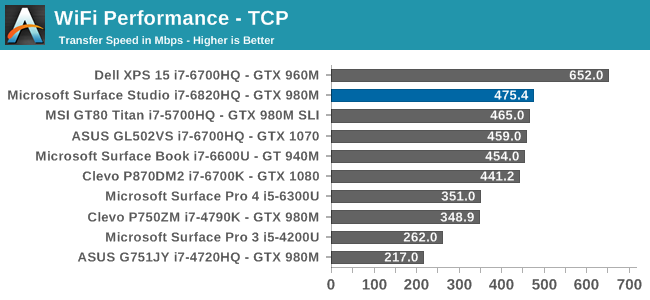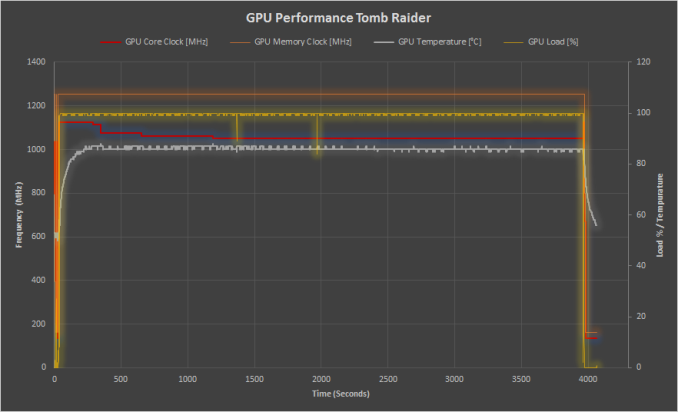The Microsoft Surface Studio Review
by Brett Howse on January 20, 2017 8:00 AM EST- Posted in
- Desktop
- Microsoft
- Surface
- Surface Studio
Wireless
Microsoft has stuck with it’s tried and tested Marvell AVASTAR 802.11ac wireless adapter for the Surface Studio, and they’ve been using this NIC for quite a while on the Surface devices, so this isn’t a surprise. Over the years, the experience with the Marvell adapter has not been the best, although recent driver updates have both improved performance, and made the adapter less prone to not finding networks to connect to.

How times have changed. The Surface Pro 4 in the above graph has the same network adapter, but you can see how far Marvell has come with the drivers. It has been solid so far in regards to connections as well, and hopefully that doesn't change. The Surface Book, with the same adapter, sometimes needs to be restarted to fix the networking even to this day.
The Surface Studio also has the Intel I219-LM Gigabit Ethernet adapter, for those that prefer a wired network connection. It does provide a better experience if you do have a cable handy, since even the best 3x3 802.11ac cards can’t really compete with Gigabit wired.
Audio
When it comes to audio, Microsoft had to put some extra work into the Surface Studio to ensure that the audio experience wasn’t impacted by too severely by moving the display. A lot more engineering went into this than you would expect, and the Surface Studio features a total of seven speakers. Apparently the Surface team decided to go big, or go home, so they fit four speakers into a downward firing grille at the bottom of the display, plus there are two additional speakers in the base. The final speaker is a subwoofer to help out on the low frequencies.
 Four of the Studio speakers are on the bottom edge of the display, and another two plus a sub are in the base
Four of the Studio speakers are on the bottom edge of the display, and another two plus a sub are in the base
The sound quality of the Surface Studio is far better than you would expect for a small, tightly packed device like it is, and having the speakers in multiple locations helps out when the display gets moved into the drafting mode, since the ones on the base can now chip in to make up for the speakers on the display no longer as optimally oriented.
The system gets quite loud, and I measured a maximum of 88 dB(A) when playing music, and the sound was not distorted even at maximum volume. The subwoofer definitely helps out too, with decent frequency response even on the low end of the scale. It’s not a home theater in a box by any means, but it would likely be enough for many people.
Thermals, and Noise
Packing a PC into a space the size of the base of a Surface Studio, especially with a GTX 980M inside, is quite a challenge, but ensuring that the system does not overheat, even under load, is often too much for small devices like this. There are two fans inside the Surface Studio, and they vent out a row of slots in the black plastic underneath the computer.
When discussing the cooling with the Surface team, they were very proud of the work they had done there, especially the amount of heat dissipated per dB of noise. In order to test the thermal capabilities of the Surface Studio, the Tomb Raider benchmark was run continuously at 1920x1080 Ultra settings, which loads the GPU up to 100%.
The cooling system is very good in the Surface Studio, despite the significant heat generated by the GTX 980M. The system was able to run for five minutes at maximum boost clock of 1126 MHz before the GPU hit the thermal limit of 87°C, at which point it reduced its frequency to 1050 MHz over time, and stayed right there for the rest of the test. Perhaps the most impressive bit is that even with the GPU at 100% load, the sound pressure level with a meter over the keyboard, was just 46 dB(A), and the sound frequency is low enough that it isn’t bothersome. Microsoft did their homework on the cooling system, and the Surface Studio is solid under load.
Where it is let down though is at idle. Despite being very quiet under load, at idle, the system still produces 37.5 dB(A), and the fans constantly run. The CPU and GPU idle around 39°C, which is very reasonable, but the sound is always there. It’s not loud, but it’s always there. For me, desktop systems should be almost silent under light workloads, but that’s not the case on the Studio, which is disappointing.
The other issue on the noise side, at least on this review unit, is that there is a small amount of coil whine when the system has the display off, but it’s not yet sleeping. Most likely, this is the power supply, which is also built into the base of the Studio, coping with the reduced power demand since it isn’t driving the display backlight anymore. Once it goes to sleep, it’s not an issue, but the system does wake up periodically to update email, and the like, so even if it is sitting there asleep on the desk, occasionally the coil whine will come back, and the fans kick in.











197 Comments
View All Comments
hoohoo - Sunday, January 29, 2017 - link
It is very nice but the price as tested is completely ridiulous.It is essentially a high spec laptop packaged in a big screen. If Asus os such were to step up it could offer the same thing for half the price.
Septillion - Wednesday, February 1, 2017 - link
So the vivid color profile aka P3 D65, is practically identical to Apple's Display P3 color profile? Same P3 primaries, D65 white point and 2.2 gamma.darwinosx - Sunday, February 5, 2017 - link
I use a Mac laptop at work and also have one at home. We have a lot of pro-Microsoft people at work including my boss who is the VP of software development. We also are working closely with Microsoft on a major project. Many of the people I work with got a Surface Pro 4 thinking they would really lie it but all of them are sick of all the issues and the service desk finally stopped allowing them because of all the issues. Several of the developers, including my boss, have Mac laptops on order now.lcf/bill - Thursday, February 9, 2017 - link
Nice to see a timely review of a product.At this point, it is looking like the Touch Bar Macbook Pro review may not be out before the hardware is revised.
IamDavid - Saturday, February 11, 2017 - link
I want to purchase the top level version but I need the ability to connect the audio to my Home Theater system. I only see a 3.5mm audio port so I assume at best I'd have stereo? Any options for have full HD audio out?macmhathain - Saturday, June 17, 2017 - link
I find this product fascinating. I'm not sure I agree that Microsoft tries to add something interesting in every computer since the Surface - they add touch to desktop PC - Suface, Surface Pro, Surface Book, Surface Laptop, and Surface studio. But, he addition of touch to a desktop PC does some very interesting things which are natural outgrowth of touch - 2 in 1 with detachable keyboard, UI that switches between desktop and tablet mode, pen support. All of these are natural outgrowths of the decision to put touch on desktops. The problem is that comes with trade-offs. The most important is cost. the Surface studio is $4000 - that would pay for an amaizngly speced out Mac or and an epically speced out traditional PC. I have heard the surface studio is slow (I don't own one but have played with it in store and based on Leo Leports comments) but what one would expect from the hardware that powers that screen (and the decision to put it into a tiny box). My wife is a professional photographer - and she really needs power in her computer. the size of her imports, running lightroom, photoshop, and a brower continually and switching between them need a powerful computer not to be slow. So the surface studio, even if it would be awesome for the occasional very precise artistic edit, wouldn't work well for the day to day grind of a photographer - and I expect the dame problem for a video editor, or graphic designer would have the same problems with lack of power. Why not attach that amazing screen to a giant box filled with i7s a ton of fast RAM and a huge SSD and a bunch of fans? sure it would cost a lot more like $10,000 - but it would do the job it is supposed to do well, unlike now where it is crippled by a trade off for aesthetics and to keep the price low (you could put at least a few better parts in the little box like a great SSD which would have helped and kept the aesthetics). I am fasciated to see who will be right. Microsoft with desktop computers need touch, or Mac that desktops needs mouse and keyboard and touch based "tablets (although a 27" ipad would be an interesting device for photo editing if it were fast enough and had enough storage)" are the only things that have touch. For me buying a computer in exchange for the additional cost for the touch screen, I'd rather have that money spent on more RAM or a better CPU or a faster SSD.Danilushka - Saturday, April 7, 2018 - link
Such a shame: Microsoft takes an innovative leap past Apple but snatched defeat from the jaws of victory sabotaged by it's buggy unreliable aged Windows operating system and poor quality control.No wonder Apple isn't rushing out large touchscreens: the competition just cannot deliver on them.
Unfortunate because competition keeps vendors innovating.